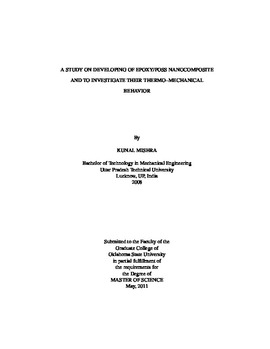| dc.contributor.advisor | Singh, Raman Pal | |
| dc.contributor.author | Mishra, Kunal | |
| dc.date.accessioned | 2014-04-17T19:53:13Z | |
| dc.date.available | 2014-04-17T19:53:13Z | |
| dc.date.issued | 2011-05-01 | |
| dc.identifier.uri | https://hdl.handle.net/11244/9998 | |
| dc.description.abstract | This study reports on the developing of epoxy/POSS nanocomposites and to investigate their thermo-mechanical behavior. Three distinct types of POSS, with trisilanol phenyl, methacryl and glycidyl functionalities are used as reinforcement of DGEB-F and DGEB-A based resin, cured using an amine based hardener. The POSS is added at low weight fraction of 0.5%, 1%, 3%, 5% and 8% by direct mechanical mixing. The mechanical properties of resin are characterized in terms of fracture toughness ( critical stress intensity factor, KIc), Work of fracture (J/m2) flexural strength (MPa) and modulus of elasticity (GPa). It is found that with increase of POSS loading the fracture toughness increases for all type of functionality. For DGEB-F based nanocomposites it increases upto 120% and with DGEB-A based resin it increase upto 40%. The value of flexural strength and modulus of elasticity was not different considering the large scattering of data. It has been found from the results of mechanical properties that POSS with greater interaction with polymer resin shows better result. The interaction between functional group of POSS and epoxy resin was showed Fourier transformation infra- red (FTIR). The differential scanning calorimetry (DSC) showed that reinforcing the POSS cause decrease in composite's Tg however being relatively greater importance for low POSS contents. The resulting fracture surface morphology were examined using scanning electron microscopy (SEM). Fractographic observation shows rougher surface for POSS reinforced resin (both DGEB-F and DGEB-A) that further indicates the evidence of extrinsic toughening mechanisms. Higher magnification of fractured surface of epoxy/POSS nanocomposites shows formation of agglomeration at high percentage of POSS loading as formation of voids and microcracks was observed. Density of neat resin and epoxy/POSS nanocomposites was measured by three different ways. Result shows that value of densities was not varying much by incorporation of POSS in resin. | |
| dc.format | application/pdf | |
| dc.language | en_US | |
| dc.publisher | Oklahoma State University | |
| dc.rights | Copyright is held by the author who has granted the Oklahoma State University Library the non-exclusive right to share this material in its institutional repository. Contact Digital Library Services at lib-dls@okstate.edu or 405-744-9161 for the permission policy on the use, reproduction or distribution of this material. | |
| dc.title | Study on Developing of Epoxy/Poss Nanocomposite and to Investigate Their Thermomechanical Behavior | |
| dc.type | text | |
| dc.contributor.committeeMember | Ausman, Kevin Douglas | |
| dc.contributor.committeeMember | Kalkan, Ali Kaan | |
| osu.filename | Mishra_okstate_0664M_11294.pdf | |
| osu.college | Engineering, Architecture, and Technology | |
| osu.accesstype | Open Access | |
| dc.description.department | Mechanical & Aerospace Engineering | |
| dc.type.genre | Thesis | |
